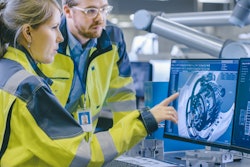
As manufacturers have struggled to improve the efficiency and profitability of their supply chains, one of the main impediments has been the sheer number of parties involved. Every additional process and interaction increases the risk of human error, miscommunication or fraud. And with labor shortages growing across the manufacturing industry, organizations can’t afford to let these problems inhibit productivity.
One promising development here is blockchain technology. Though blockchain has mostly been associated with cryptocurrency, the immutability and transparency of a blockchain-powered network are actually perfectly suited for the complexities of supply chains. By enabling manufacturers to quickly and seamlessly share accurate supply-chain data with their many partners, blockchain can help companies simplify a host of essential processes, reduce operational hazards and ultimately meet demand with greater ease.
Transparency between partners
The first step towards supply chain optimization is making information more accessible. A major operational hazard with supply chains is that information is often siloed in internal departments or at external partners such as distributors, vendors, retailers, etc. Rather than obtaining information from a single source, different departments and organizations store their own data, often in their own format. As a result, data must be shared manually and more frequently, which increases the likelihood of miscommunication as well as the inadvertent sharing of outdated information.
Blockchain technology, however, eliminates the probability of inaccurate data by logging the entire lifecycle of a manufactured product in a secure yet public database. This creates a single source of valid information for all supply chain partners. And once a block of information is logged onto the blockchain, it cannot be modified or deleted. So, not only can each party access the same information at any given moment, but they also have no reason to doubt the information’s accuracy. This dramatically reduces the risk of miscommunication, especially errors that arise from outdated information.
Moreover, the ability to share new information in real-time enables manufacturers to practice just-in-time production, responding to genuine demand. When demand for a certain item suddenly increases, the company’s partners in the supply chain can simply access the blockchain’s real-time data to promptly distribute the necessary materials and resources. Consumers will receive their purchases on time and the manufacturer will have avoided ordering unnecessary large quantities of inventory and diminishing profitability.
End-to-end traceability
As the lone source of information for the supply chain process, the blockchain’s digital ledger can record data from all parties involved. For example, when a certain material is purchased to be used for production, the ledger will record the bill of sale. So, in the event of a regulatory audit, manufacturers can log onto the network to verify the origins of their raw materials, even though the data pertains to or comes from another party. Similarly, blockchain can clearly exhibit a manufacturer’s compliance with various environmental regulations through its records of each party’s usage of fossil fuels and essential resources like water or electricity.
Under normal circumstances, each party would compile and provide its own data, which would be virtually impossible to verify. Since blockchain data cannot be changed, manufacturers don’t have to worry about suppliers altering data for fraudulent purposes or counterfeit materials unknowingly entering their processes, both of which are surprisingly common.
When supply chain data is divided among various parties, such an arrangement creates a distrustful culture in which each party is motivated to prioritize its own interests and find its own pathways to success. In many cases, the parties are separated to such a degree that they don’t necessarily care how their actions impact the success of their partners. Blockchain has the opposite effect: it builds trust between parties by unifying them around shared information and a common goal.
Automation through smart contracts
Blockchain can also maximize operational efficiency through smart contracts, which are self-executing processes with embedded rules that codify agreements between parties. For example, a smart contract could be programmed to automatically send a payment to a supply chain partner once the specific parameters of an order have been met, e.g., the delivery of raw or finished goods. There’s no need for human workers to issue an invoice, get the invoice approved or initiate the payment manually.
Likewise, a smart contract could be programmed to send new pricing requests or charges to supply chain partners once production reaches and exceeds a predetermined purchasing threshold. A smart contract can also contain automatic triggers for corrective measures when a delivery occurs outside of a predetermined schedule or a member of the supply chain delivers an incorrect quantity of inventory.
Given the aforementioned labor shortages, smart contracts can automate many of the tedious administrative tasks involved in a complex supply chain. Managers can focus entirely on adding value to supply chains, rather than constantly communicating with different partners or correcting errors in documentation.
Encouraging blockchain adoption
Admittedly, blockchain represents a major deviation from traditional supply chain practices. The widespread adoption of blockchain into the manufacturing industry comes with several hurdles, beginning with the lack of familiarity with how the technology works. Blockchain’s applications in supply chains must become mainstream industry knowledge before manufacturers can consider implementing blockchain technology.
Another impediment to adoption of blockchain is the technology’s common association with cryptocurrency. Companies need to understand that blockchain is no more endemic to crypto speculation and market volatility than telephones were to the Great Recession of 2008. Yes, blockchain was involved in the hype and subsequent financial fallout from cryptocurrency, much as speculative bankers used phones during the process leading up to the Great Recession. But neither was necessarily the cause of any financial woes.
Also, manufacturers and their partners may not be comfortable with the transparency of blockchain’s digital ledger. In a blockchain network, all participating partners will be able to view information that might normally be confidential, like contractual agreements and financial data. In order to establish agreed-upon standards and other essential components of a blockchain network, all parties must solidify their mutual trust and accept their direct connections to each other’s success. Lastly, manufacturers must make sure that they are only sharing relevant data that adds value to the blockchain network, as opposed to carelessly giving away personal or sensitive information, like trade secrets.
Supply chains are currently under tremendous pressure to make improvements in efficiency and productivity. To meet unprecedented levels of demand, supply chains need to mitigate opportunities for miscommunication and fraud. If manufacturers fail to acknowledge blockchain’s potential to mitigate these challenges, the complexities that already inhibit the growth of their organizations will only get worse in the years to come.















![Pros To Know 2026 [color]](https://img.sdcexec.com/mindful/acbm/workspaces/default/uploads/2025/08/prostoknow-2026-color.mduFvhpgMk.png?ar=16%3A9&auto=format%2Ccompress&bg=fff&fill-color=fff&fit=fill&h=135&q=70&w=240)


